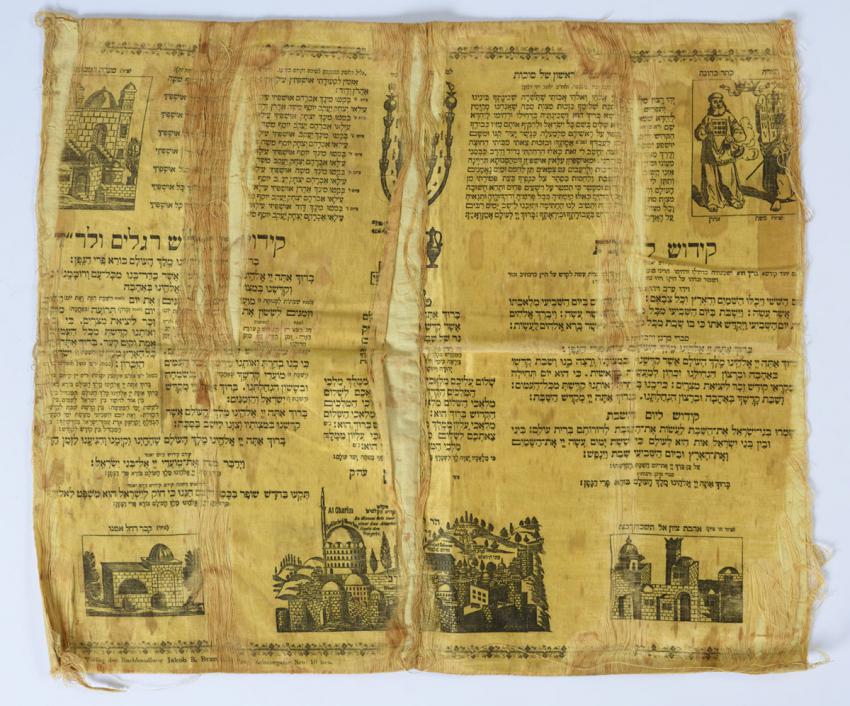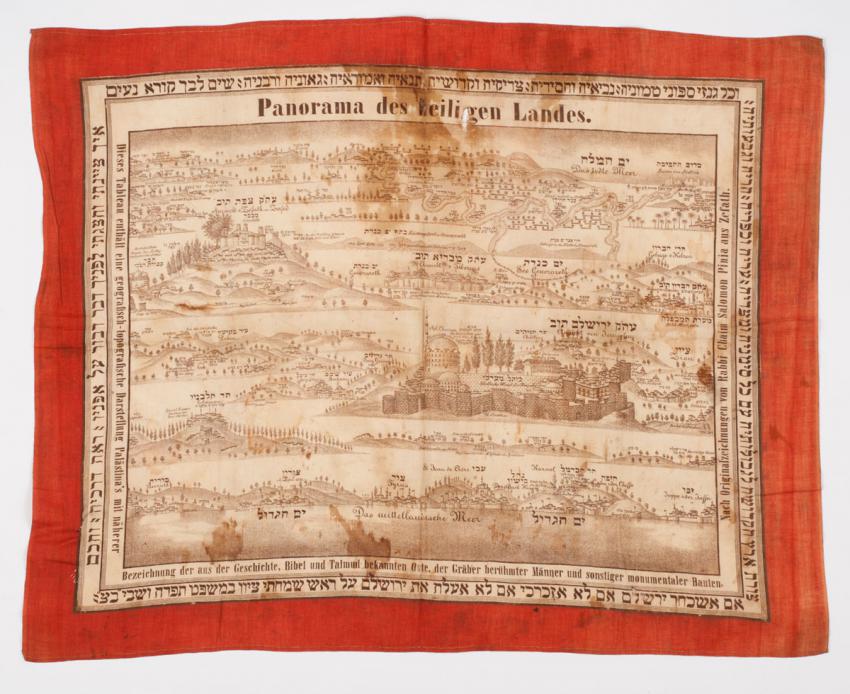In November 1996, representatives of the Yad Vashem Museums Division travelled to Romania to follow the trail of Jewish communities that flourished there before the war and to find remnants of these communities. In towns and villages along the way they found synagogues that had been closed since the Holocaust. In addition to Torah Arks and synagogue furnishings, they found ritual articles that had been stored together with them. Many of the items they found were transferred to the Yad Vashem Artifacts Collection for preservation.
In the town of Botosani in Romania, they were given a fascinating silk challah cover embellished with illustrations and the Kiddush (sanctificationof the wine) prayer said on the New Year and Sukkot (Tabernacles) holiday, as well as additional prayers for Sukkot. This item is typical of souvenirs from the Holy Land that were very popular before the war in Jewish communities in the Diaspora. This challah cover appears to be for use during the month of Tishrei and in particular for use at the meals held in the Sukkah when it is traditional to invite the "Ushpizin" guests. According to Kabbalistic tradition, the forefathers of the Jewish people, Abraham, Isaac and Jacob, Joseph, Moses, Aaron and David are invited, one each day, to visit the Sukkah.
The version of the wording on this cloth is according to the tradition of the "Ari", the greatest of the sixteenth century Safed Kabbalists: "Azmin leSeudati Ushpizin Ila'in". His teachings and the version of the prayers named after him, were common initially among Sephardic Jews in Eretz Israel and its vicinity, until they were spread by the Hasidic teachings of the Ba'al Shem Tov in Eastern Europe.
Centered between the texts of the prayers is an illustration of the Temple Menorah (seven-branched candelabra) and its accompanying implements, an image that was common in holy texts even before the advent of the printed book. Also featured on the challah cover is an illustration of the "Holy City of Jerusalem" that originally appeared on a printed cloth, "Panorama of the Holyland" attributed to Rabbi Pinia of Safed, from the mid-nineteenth century. Large lithographs of this illustration printed on paper or cloth were common as wall decorations in the homes of affluent Jews in Romania.
Depicted in each of the four corners of the cloth are holy sites in Eretz Israel: the Cave of the Patriarchs, Mt. Zion, Rachel's Tomb and an illustration of Moses and Aaron captioned "crown of Torah" and "crown of priesthood".
The subjects of the illustrations on the cloth are well-known from assorted Judaica artifacts, among them "Mizrach" plaques and synagogue murals in Jewish communities throughout the Diaspora and in Romania in particular, but the integration of these illustrations and the Tishrei holiday prayers on one challah cloth is distinctive.
From the nineteenth century onward, depictions of the holy sites in Eretz Israel as well as the illustration of Moses and Aaron, common in early printed Passover Haggadahs and other religious texts, were reworked by Jewish folk artists in Eretz Israel and these became a new visual language for souvenirs of the Holy Land.
One of the catalysts for the proliferation of souvenirs manufactured in Eretz Israel was the need to raise funds for Jewish communities in the Galilee after the devastating earthquake of 1837. Following the distribution in Europe of a poster drawn in Tiberias by Chaim Moshe Solomon Luria, authentic posters and pseudo-copies featuring images of places in Eretz Israel started appearing in Jewish communities throughout the Diaspora. They were copied in Europe and their distribution increased until they were commonly found in different formats including many synagogue decorations. According to the text printed in the corner of this challah cover, it was printed in Prague but as discussed above, the origin of the images is Eretz Israel.
The challa cover preserved in Yad Vashem's Artifacts Collection is evidence of the rich cultural and religious life in Romanian communities before the Holocaust. The illustrations depicted on it testify to the strong attachment to and longing for Eretz Israel that grew during the nineteenth century alongside the dissemination of the ideas of Zionism and immigration to Eretz Israel.
Artifacts Collection, Museums Division, Yad Vashem
Donated by the community of Botosani, Romania










